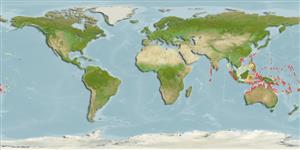>
Anguilliformes (Eels and morays) >
Chlopsidae (False morays)
Etymology: Kaupichthys: Because of Johann Jakob Kaup, 1827; author of "Zoologische Monographien", ichthyologist + Greek, ichthys = fish.
More on author: Schultz.
Environment: milieu / climate zone / depth range / distribution range
Ekologi
marina revassocierade; djupintervall 1 - 20 m (Ref. 86942). Tropical; 30°N - 24°S
Indo-Pacific: Chagos Islands to Samoa, north to Ryukyu Islands, south to the southern Great Barrier Reef; throughout Micronesia.
Size / Vikt / Age
Maturity: Lm ? range ? - ? cm
Max length : 12.0 cm TL hane/ej könsbestämd; (Ref. 30874)
Short description
Morfologi | Morfometri
Ryggkotor: 107 - 112.
A small uncommon species which inhabits coral heads to depths of at least 14 m.
Life cycle and mating behavior
Könsmognad | Reproduktion | Lek | Ägg | Fecundity | Larver
Myers, R.F., 1991. Micronesian reef fishes. Second Ed. Coral Graphics, Barrigada, Guam. 298 p. (Ref. 1602)
IUCN Red List Status (Ref. 130435)
Threat to humans
Harmless
Human uses
Ytterligare information
PopulärnamnsynonymerMetabolikPredatorerEkotoxikologiReproduktionKönsmognadLekSpawning aggregationFecundityÄggEgg development
Age/SizeTillväxtLength-weightLength-lengthLength-frequenciesMorfometriMorfologiLarverLarvdynamikRekryteringAbundansBRUVS
referenserVattenbrukVattenbruksprofilAvelslinjerGenetikElectrophoresesÄrftlighetSjukdomarBehandlingNutrientsMass conversion
MedarbetareBilderStamps, Coins Misc.LjudCiguateraHastighetSimsättGälytaOtolithsHjärnstorlekSyn
Verktyg
Special reports
Download XML
Internet-källor
Estimates based on models
Preferred temperature (Ref.
123201): 25.2 - 29.3, mean 28.5 °C (based on 1596 cells).
Phylogenetic diversity index (Ref.
82804): PD
50 = 0.5156 [Uniqueness, from 0.5 = low to 2.0 = high].
Bayesian length-weight: a=0.00102 (0.00046 - 0.00225), b=3.06 (2.88 - 3.24), in cm total length, based on all LWR estimates for this body shape (Ref.
93245).
Trofisk nivå (Ref.
69278): 3.6 ±0.5 se; based on size and trophs of closest relatives
Fishing Vulnerability (Ref.
59153): Low vulnerability (10 of 100).
Nutrients (Ref.
124155): Calcium = 86 [44, 175] mg/100g; Iron = 0.59 [0.32, 1.15] mg/100g; Protein = 18.2 [15.9, 20.8] %; Omega3 = 0.13 [0.05, 0.37] g/100g; Selenium = 21 [9, 49] μg/100g; VitaminA = 251 [58, 967] μg/100g; Zinc = 1.73 [1.11, 2.53] mg/100g (wet weight);
